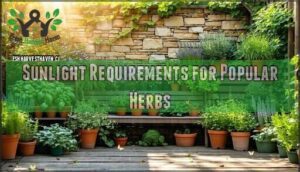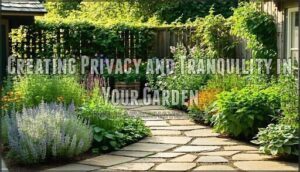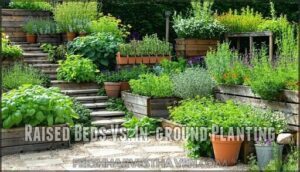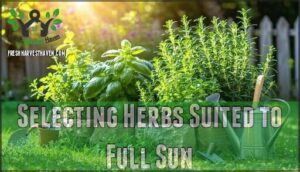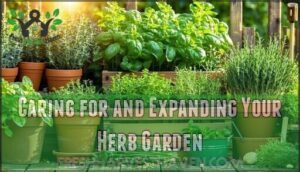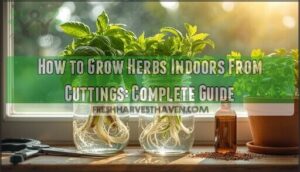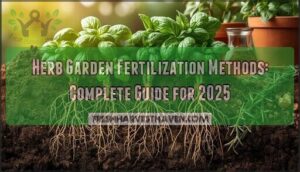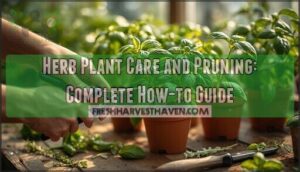This site is supported by our readers. We may earn a commission, at no cost to you, if you purchase through links.
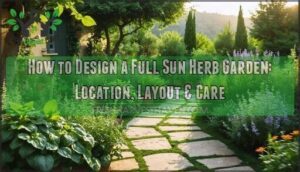
You need to understand microclimates, soil drainage, and which Mediterranean varieties actually love your blazing afternoon heat versus which ones secretly crave a bit of shade. Get the location and layout right from the start, and you’ll harvest armfuls of fragrant leaves all season long.
Skip these fundamentals, and you’ll wonder why your neighbors’ herbs flourish while yours barely survive. The difference comes down to intentional design choices that work with the sun’s intensity rather than against it.
Table Of Contents
Key Takeaways
- Successful herb garden design in full sun hinges on intentional choices about location, soil drainage, and microclimates—not just finding a sunny spot and hoping Mediterranean herbs will thrive without proper planning.
- Most full sun herbs demand six to eight hours of direct sunlight daily and well-draining, lean soil to develop peak flavor compounds, with proper drainage being the difference between thriving plants and waterlogged disasters.
- Smart garden layouts combine structural choices like raised beds or quadrant designs with strategic plant selection, pairing drought-tolerant Mediterranean varieties together while using containers to control invasive spreaders like mint.
- Long-term success requires ongoing soil renewal through composting and mulching, regular pruning to prevent woody growth, and propagation techniques that expand your garden without additional costs while maintaining soil health through crop rotation.
Choosing The Best Location for Full Sun Herbs
Your herb garden’s success starts with choosing the right spot—and it’s about more than just pointing at a sunny patch of yard.
You need to think through sunlight intensity, soil conditions, privacy, and whether raised beds or ground planting makes sense for your space.
Let’s break down what actually matters when picking your location.
Sunlight Requirements for Popular Herbs
How do your favorite herbs measure up regarding sunlight intensity and herb light requirements? Most full sun herbs demand six to eight hours of direct light daily for peak photosynthesis rates and flavor. Basil and thyme won’t tolerate shortcuts—drop below six hours and you’ll see yield drop by 40 percent or more. Rosemary craves seven-plus hours to develop those prized flavor compounds, while oregano follows similar rules for vigorous essential oil production.
Most full sun herbs demand six to eight hours of direct light daily—drop below that and you’ll watch yield plummet by 40 percent or more
Mint breaks the mold, thriving in partial shade with just two to four hours, making it your ace for trickier spots.
Understanding these sunlight requirements and plant hardiness zones helps you avoid leaf scorch and design a thriving herb garden layout where every plant owns its space. To enhance growth, consider the specific needs of sun loving herbs when planning your garden.
Assessing Soil Drainage and Quality
You’ve nailed the sunlight—now let’s talk about what’s happening six inches below the surface, where drainage separates thriving herbs from waterlogged disasters. Soil testing reveals your soil composition for herbs—grab a handful and squeeze it. Does it clump like clay or crumble freely?
Loamy soil with good drainage systems wins every time. Check your water table, address soil compaction with compost, and create a soil mix that prevents erosion control issues while maintaining ideal soil quality for peak growth.
Creating Privacy and Tranquility in Your Garden
Your herb garden isn’t just about what grows—it’s about where you can disappear, away from the noise, the neighbors, and the chaos that follows you everywhere else.
Think garden seclusion as non-negotiable. Use natural barriers like shrubs or trellises to create peaceful landscaping that shields your quiet retreat.
Position your full sun herbs where serene spaces meet strategic herb garden design—maybe tucked behind the garage or nestled in a corner where nobody thinks to look.
Raised Beds Vs. In-ground Planting
Once you’ve carved out that peaceful corner, the next battle is deciding whether to build up with raised beds or go straight into the ground—and trust me, this choice shapes everything from drainage to how much your back will hate you next spring.
Raised beds give you total control over soil conditions and drainage systems, perfect for full sun herb gardening when your native dirt is clay-heavy or waterlogged. Bed construction means better garden accessibility and easier bed maintenance, but in-ground planting works beautifully if your soil elevation and natural drainage already cooperate with your herb garden design ambitions.
Designing an Attractive Herb Garden Layout
Once you’ve nailed down the perfect sunny spot, it’s time to bring your vision to life with a layout that’s both functional and beautiful.
The design you choose sets the tone for your entire garden, whether you want crisp geometric lines or a more relaxed, flowing feel. Let’s look at the styles and structures that’ll turn your herb patch into something truly special.
Formal Vs. Informal Herb Garden Styles
Think of herb garden styles as two sides of the same coin—one demands precision and order, while the other celebrates a wild, untamed beauty that feels more like organized chaos than careful curation.
Formal designs command respect with geometric patterns, straight lines, and neatly trimmed hedges where symmetry rules absolute.
Informal herb garden styles break free from rigid garden aesthetics, embracing natural landscapes with meandering paths and relaxed plantings that still deliver serious impact.
Quadrant and Apothecary Garden Designs
The quadrant design—a centuries-old European tradition—divides your herb garden into four equal sections separated by intersecting paths, creating both function and visual drama that never goes out of style. Each herb quadrant can showcase specific varieties based on use or growing needs, while the geometric patterns deliver instant garden symmetry.
The apothecary layout takes this further with a curated selection of multi-functional herbs—think medicinal powerhouses mixed with culinary stars—perfectly suited for raised beds in full sun conditions.
Maximizing Space With Paths and Borders
Smart paths don’t just connect your herbs—they carve out precious growing real estate while giving you easy access to every plant without compacting the soil around their roots.
Choose pathway materials like gravel or stepping stones that keep your footprint narrow—18 inches works perfectly—while border designs using stone edging techniques or low hedges define each bed’s boundaries and optimize garden space.
This garden accessibility strategy transforms raised beds into productive powerhouses where every square inch counts.
Container Options Like Round Hot Dipped Steel Tubs
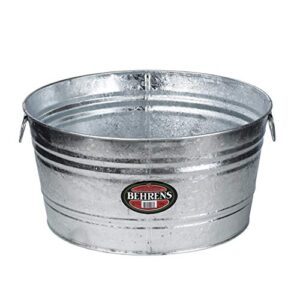
When ground space runs thin, round hot-dipped steel tubs become your secret weapon—offering depth, durability, and a weatherproof fortress that plastic containers simply can’t match.
These metal garden containers excel as herb planters for full sun exposure, transforming container gardening into serious production:
- 17-gallon capacity gives roots room to spread—essential for Mediterranean herbs like rosemary
- Steel tub planters resist rust and rodents while staying stable in harsh weather
- Offset bottoms prevent waterlogging, vital for well-draining outdoor planters
This herb garden design approach turns any patio into productive growing space.
Selecting Herbs Suited to Full Sun
Picking the right herbs for your sun-drenched space isn’t just about what survives—it’s about building a garden that thrives with minimal fuss and maximum flavor.
You want plants that can tolerate the heat, deliver what you need in the kitchen or medicine cabinet, and look stunning while doing it.
Let’s break down which herbs deserve a spot in your full-sun lineup.
Mediterranean and Sun-loving Herb Varieties
Mediterranean herbs are your garden’s MVPs—they practically thrive on neglect. Rosemary, thyme, oregano, and lavender don’t just tolerate full sun; they demand it, having evolved in rocky, sun-drenched hillsides where rainfall is scarce.
These sun-loving varieties share similar climate adaptation needs: lean soil, excellent drainage, and at least six hours of direct sunlight. Pair drought-tolerant herbs together for efficient watering and maintenance.
To create a thriving herb garden, consider the importance of well draining soil for ideal growth.
Annuals Vs. Perennials: What to Plant
Building a perennial backbone for your herb garden isn’t just smart planning—it’s the difference between starting from scratch every spring and walking into an established oasis that welcomes you back year after year. Perennial herbs anchor your full sun garden design with minimal fuss, while annuals like basil and dill fill gaps with explosive growth habits.
Smart plant choices mean blending both—perennials for garden longevity, annuals for abundant harvests. Rotate annual herb varieties through different spots each season for healthier soil and stronger crops.
Herbs for Culinary and Medicinal Use
Your best herb choices pull double duty—stacking culinary flavor with legitimate medicinal properties so every plant earns its place in your full sun garden.
Rosemary and thyme dominate Mediterranean herb classification, thriving in lean soil while delivering aromatic herbs for roasts and herbal remedies for digestion. Oregano amplifies your culinary herbs arsenal and fights inflammation.
Lavender calms nerves and perfumes desserts—pure multitasking genius for growing herbs in full sun gardens.
Pollinator-friendly Herb Choices
Beyond flavor and medicine, herbs that feed pollinators enhance your garden ecosystem while stacking pollinator diversity and native plants advantages.
Chives, lavender, and borage rank as bee-friendly superstars—studies show mountain mint and anise hyssop draw both bees and butterflies into full sun herb gardens. Let dill, parsley, and fennel bolt for swallowtail butterflies.
Species-rich pollinator gardens boost local bee abundance by 45% compared to solo plantings, turning herb gardening tips into ecosystem wins.
Soil Preparation and Sustainable Maintenance
Your soil sets the stage for everything that follows—it’s where roots dig in, nutrients flow, and resilience takes hold. Getting the foundation right means less wrestling with problems later and more time enjoying what grows.
Here’s how to build soil that works with you, not against you.
Creating Well-drained, Fertile Soil
The secret to growing thriving herbs isn’t just about dumping them in dirt and hoping for the best—it starts with building a foundation that drains fast and feeds slow. Here’s your game plan for creating well-draining soil with the right nutrient balance:
- Mix coarse sand or perlite into heavy clay to improve drainage systems and soil composition
- Layer 2-3 inches of compost for nutrient-rich soil without overwhelming Mediterranean varieties
- Test soil conditions to verify proper pH (6.0-7.0 works for most herbs)
- Add grit or gravel at the planting hole base for extra-thirsty herbs like rosemary
- Keep soil lean—herbs don’t need fertilizer types designed for vegetables
That’s the foundation your herb garden design needs to succeed.
Mulching, Composting, and Organic Fertilization
Once you’ve nailed the drainage, keeping that soil healthy long-term means feeding it right—and that’s where mulch, compost, and the occasional organic boost come into play.
Spread organic mulch around plants to lock in moisture and suppress weeds while slowly enriching herb soil with natural fertilizers. Layer in compost or brew compost tea for nutrient requirements without going overboard—sustainable gardening practices mean feeding the soil, not force-feeding your organic herbs.
Green manure and thoughtful soil amendments keep your garden self-sufficient and thriving season after season.
Adjusting Soil PH for Different Herbs
Most herbs thrive in soil with a pH between 6.0 and 7.0, but achieving this balance requires understanding pH testing methods and amendment application timing.
Test your herb garden soil before planting—digital meters provide quick reads on soil conditions, while colorimetric kits work in a pinch.
If you’re dealing with acidic soil, lime raises pH and enhances nutrient availability; sulfur lowers it when conditions become too alkaline.
Make gradual adjustments to protect established roots, and remember that herb soil and nutrient requirements shift as rainfall and fertilization influence pH over time.
Watering Practices for Healthy Roots
Getting the water balance right separates thriving herb gardens from struggling ones—too much drowns roots, too little leaves them parched and bitter.
Check soil moisture by pressing your finger two inches deep—if it’s dry, water deeply to encourage root depth management.
Drip irrigation systems deliver consistent moisture, while water conservation methods prevent root rot in full sun herb gardens, keeping nutrient-rich soil perfectly balanced without waste.
Caring for and Expanding Your Herb Garden
Your herb garden isn’t a "set it and forget it" project—it’s a living space that rewards ongoing attention and smart expansion.
Regular care keeps your plants productive, while strategic propagation and soil renewal let you multiply what works and phase out what doesn’t.
Here’s how to maintain momentum and take control of your garden’s evolution.
Pruning and Harvesting Techniques
Mastering the art of the snip—knowing when and how to prune—is what separates a thriving herb garden from a scraggly patch of half-hearted stems. Your pruning tools become instruments of transformation when you follow these three rules:
- Harvest in the morning after dew dries but before full sun hits—that’s when essential oils peak
- Cut stem sections just above leaf nodes to encourage bushy, vigorous growth
- Remove no more than one-third of the plant at once to keep roots strong
Regular leaf pruning keeps your full sun herb garden productive and prevents woody, bitter growth.
Dividing, Propagating, and Rotating Herbs
Think of perennials as the gift that keeps on giving. Splitting overgrown clumps every few years doesn’t just multiply your plants, it rejuvenates them at the root level and gives you free herbs to scatter throughout your garden or trade with friends.
Root separation works beautifully for chives and oregano in raised beds, while stem cuttings from rosemary and thyme root quickly in full sun.
Master herb propagation through leaf cuttings or seed starting, and you’ll design an ever-expanding herb garden without spending a dime on new herb planting stock.
Refreshing Soil and Adding New Varieties
Your soil isn’t spent—it’s just tired, and a simple refresh can reignite your garden’s potential while making room for bold new flavors. Top-dress with compost or pour compost tea over full sun beds to restore nutrient requirements without disturbing roots.
Herb rotation prevents depletion—swap heavy feeders for lean Mediterranean herb varieties. Garden renewal means seizing soil conditions as they shift, and herb garden design thrives when new varieties challenge the status quo.
Managing Invasive Herbs Like Mint and Basil
Mint and basil don’t just grow—they stage a hostile takeover, and without firm boundaries, they’ll crowd out everything you’ve worked to establish.
Plant mint in containers with root barriers or submerged pots to enforce herb containment in full sun herb garden design. Prune basil weekly to prevent seeding, maintaining pest control and vigor.
Invasive herb control isn’t optional—it’s how you protect the garden you designed.
Frequently Asked Questions (FAQs)
How do you winterize herbs in full sun?
Winterizing full sun herbs starts before frost hits. Mulch around cold-hardy perennials like thyme for soil insulation, while tender herbs need cold frames or indoor relocation.
Proper frost management separates thriving overwintering herbs from casualties.
What pests commonly affect sun-loving herbs?
Aphids, whiteflies, and spider mites are the troublemakers you’ll face most often. Fungal diseases can sneak in when humidity spikes, so good airflow and pest control in herb gardens matter.
Plant pest-resistant herbs like rosemary alongside your culinary herbs for natural protection.
Can herbs get too much sunlight?
Picture a scorched rosemary plant, its leaves bleached and crispy despite its Mediterranean origins. Yes, even sun-worshipping herbs can suffer from excessive Light Intensity and Heat Stress.
While most herbs thrive in full sun, extreme heat above 95°F combined with intense Sunlight exposure can overwhelm their Photosynthesis Rates, causing leaf scorch and wilting. Strategic afternoon Shade Requirements during brutal summers protect your Herb Garden Design investment.
How do you design vertical herb gardens?
Vertical planters and wall gardens let you stack herb towers upward when space is tight. Mount trellis systems or pocket planters on sunny walls, then fill them with full sun herb varieties like thyme, oregano, and rosemary for a space-saving container gardening setup.
What companion plants work with full sun herbs?
Don’t worry—companion planting won’t complicate your design.
Pair your Culinary Herbs with marigolds, zinnias, or nasturtiums to attract Beneficial Insects, strengthen your Garden Ecosystem, and add vibrant Full Sun Flowers that improve both beauty and function through strategic Herb Pairings.
Conclusion
Don’t let your herb garden become a cautionary tale whispered among neighbors. Once you’ve nailed the fundamentals of herb garden design full sun—location, drainage, and strategic layout—you’re no longer gambling with wishful thinking.
You’re architecting a fragrant, productive ecosystem that thrives under intense sunlight instead of wilting beneath it. Commit to these intentional choices now, and you’ll harvest abundance while others troubleshoot failures.
Your sun-drenched plot doesn’t need luck; it needs the right blueprint executed with confidence.
- https://www.rareseeds.com/
- https://www.botanicalinterests.com/
- https://www.botanicalblueprint.com/post/top-tips-for-growing-herbs-sunlight-needs-perfect-plant-combos
- https://www.newlifeonahomestead.com/which-herbs-grow-well-indoors/
- https://www.reddit.com/r/gardening/comments/21ymp1/herbs_that_do_well_in_full_sunlight/

